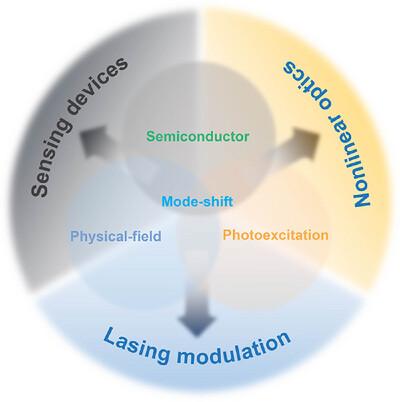基于外部物理场的动态调制激光模式研究进展
IF 10
1区 物理与天体物理
Q1 OPTICS
引用次数: 0
摘要
波长可调谐激光器因其在生物医学、光谱学、信息科学和集成光学等领域具有巨大的应用潜力,一直备受关注。具有非对称中心结构的半导体材料,如ZnO、GaN、CdS和钙钛矿,具有压电和压阻效应,为实现激光模式选择输出和动态调制提供了可行的途径。本文成功地获得了不同半导体光腔中激光模式输出的动态规律,并利用压电和压阻的协同效应实现了单模激光器。此外,还进一步探索和拓展了该调制方法在非线性光学和应变传感领域的应用。这一系列研究结果充分证明,该调制机制不仅适用于不同材料体系中腔模谐振频率的动态调节,而且为利用超窄脉宽激光移模开发新型非接触高精度应变传感器提供了有效策略。本文章由计算机程序翻译,如有差异,请以英文原文为准。

Recent Progress in Dynamically Modulating Lasing Mode Based on External Physical Fields
The research and development of wavelength-tunable lasers has always attracted much attention due to their huge potential applications in the fields of biomedicine, spectroscopy, information science, and integrated optics. Semiconductor materials with asymmetric center structures, such as ZnO, GaN, CdS, and perovskite, exhibit both piezoelectric and piezoresistive effects, which provide a feasible path for the realization of lasing mode selective output and dynamic modulation. In this review, the dynamic regulation of lasing mode output is obtained in different semiconductor optical cavity in succeed, and realized the single-mode laser by utilizing the synergistic effect of piezoelectricity and piezoresistivity. In addition, the application of this modulated method in the field of nonlinear optics and strain sensing is also further explored and expanded. This series of research results fully proves that this modulation mechanism is not only suitable for the dynamic regulation of the resonant frequency of cavity mode in different material systems, but also provides an effective strategy for the development of a new type of non-contact, high-precision strain sensors by taking advantage of the ultra-narrow pulse width lasing mode-shift.
求助全文
通过发布文献求助,成功后即可免费获取论文全文。
去求助
来源期刊
CiteScore
14.20
自引率
5.50%
发文量
314
审稿时长
2 months
期刊介绍:
Laser & Photonics Reviews is a reputable journal that publishes high-quality Reviews, original Research Articles, and Perspectives in the field of photonics and optics. It covers both theoretical and experimental aspects, including recent groundbreaking research, specific advancements, and innovative applications.
As evidence of its impact and recognition, Laser & Photonics Reviews boasts a remarkable 2022 Impact Factor of 11.0, according to the Journal Citation Reports from Clarivate Analytics (2023). Moreover, it holds impressive rankings in the InCites Journal Citation Reports: in 2021, it was ranked 6th out of 101 in the field of Optics, 15th out of 161 in Applied Physics, and 12th out of 69 in Condensed Matter Physics.
The journal uses the ISSN numbers 1863-8880 for print and 1863-8899 for online publications.

 求助内容:
求助内容: 应助结果提醒方式:
应助结果提醒方式:


